

Www.cs.ucdavis.edu/~matloff/matloff/public_html/unix.html. Managing Modularity: Makefiles and Libraries. Norman Matloff Department of Computer Science University of California at Davis (530) 752-1953 matloff@cs.ucdavis.edu July 4, 2005.

Home - HOWTO for g++ and Makefile. G++

A Simple Makefile Tutorial. Makefiles are a simple way to organize code compilation.
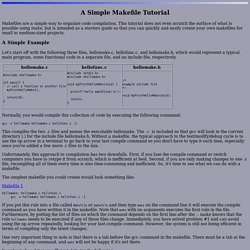
This tutorial does not even scratch the surface of what is possible using make, but is intended as a starters guide so that you can quickly and easily create your own makefiles for small to medium-sized projects. A Simple Example Let's start off with the following three files, hellomake.c, hellofunc.c, and hellomake.h, which would represent a typical main program, some functional code in a separate file, and an include file, respectively. Normally, you would compile this collection of code by executing the following command: Make'
GNU make This file documents the GNU make utility, which determines automatically which pieces of a large program need to be recompiled, and issues the commands to recompile them.
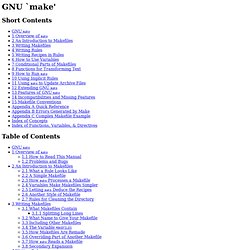
Error Messages - GNU `make' Here is a list of the more common errors you might see generated by make, and some information about what they mean and how to fix them.

Sometimes make errors are not fatal, especially in the presence of a - prefix on a recipe line, or the -k command line option. Errors that are fatal are prefixed with the string ***. Error messages are all either prefixed with the name of the program (usually ‘make’), or, if the error is found in a makefile, the name of the file and line number containing the problem. In the table below, these common prefixes are left off. ‘[] Error ’‘[] ’ Www.linfo.org/make_alias_permanent.html. Git-cheat-sheet-medium.png (1100×850) SHA-1. In cryptography, SHA-1 is a cryptographic hash function designed by the United States National Security Agency and is a U.S.
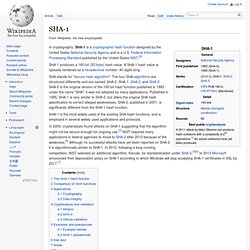
Federal Information Processing Standard published by the United States NIST.[2] SHA-1 produces a 160-bit (20-byte) hash value. A SHA-1 hash value is typically rendered as a hexadecimal number, 40 digits long. SHA stands for "secure hash algorithm". The four SHA algorithms are structured differently and are named SHA-0, SHA-1, SHA-2, and SHA-3. SHA-1 is the most widely used of the existing SHA hash functions, and is employed in several widely used applications and protocols.
In 2005, cryptanalysts found attacks on SHA-1 suggesting that the algorithm might not be secure enough for ongoing use.[3] NIST required many applications in federal agencies to move to SHA-2 after 2010 because of the weakness.[4] Although no successful attacks have yet been reported on SHA-2, it is algorithmically similar to SHA-1. Reference. This website uses cookies.

By continuing, you give permission to deploy cookies, as detailed in our privacy policy. ok Search: Reference Not logged in Reference Standard C++ Library reference C Library The elements of the C language library are also included as a subset of the C++ Standard library. C++ Tutorial. C++ Coding Standard. Last Modified: 2008-03-01 tmh@possibility.com / To make comments on this page please see the new Disqus comment section.
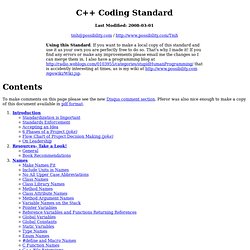
Pferor was also nice enough to make a copy of this document available in pdf format. Standardization is Important It helps if the standard annoys everyone in some way so everyone feels they are on the same playing field. Good Points When a project tries to adhere to common standards a few good things happen: Programmers can go into any code and figure out what's going on.
Bad Points Now the bad: The standard is usually stupid because it was made by someone who doesn't understand C++. Discussion The experience of many projects leads to the conclusion that using coding standards makes the project go smoother. Standards Enforcement First, any serious concerns about the standard should be brought up and worked out within the group. IBM AIX Compilers. Additional Resources for ECS 60. How To Look Like A UNIX Guru. Terence Parr Last updated: August 30, 2006 Translations: UNIX is an extremely popular platform for deploying server software partly because of its security and stability, but also because it has a rich set of command line and scripting tools.
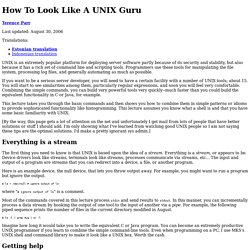
Programmers use these tools for manipulating the file system, processing log files, and generally automating as much as possible. If you want to be a serious server developer, you will need to have a certain facility with a number of UNIX tools; about 15. This lecture takes you through the basic commands and then shows you how to combine them in simple patterns or idioms to provide sophisticated functionality like histogramming. [By the way, this page gets a lot of attention on the net and unfortunately I get mail from lots of people that have better solutions or stuff I should add.
Everything is a stream The first thing you need to know is that UNIX is based upon the idea of a stream. . $ ls > /dev/null # ignore output of ls.